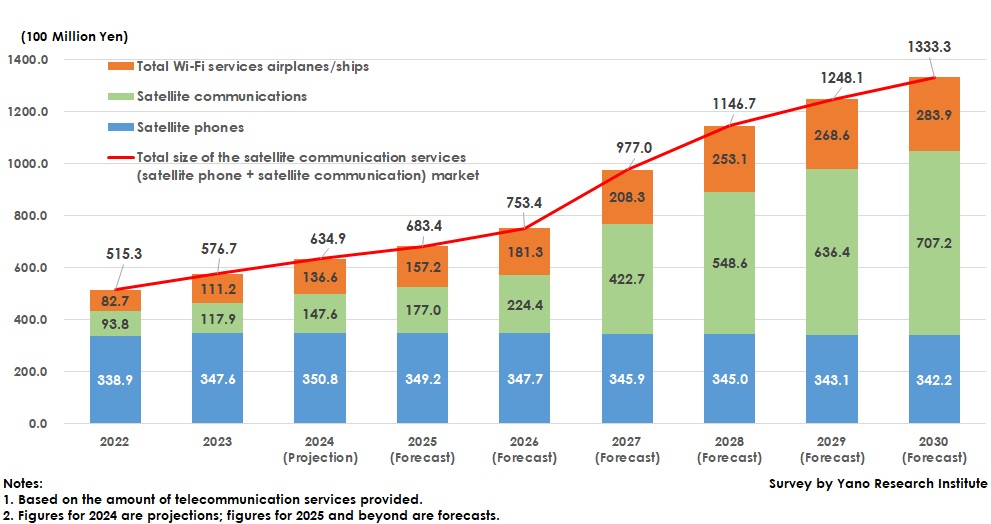No.3611
Satellite Communication Service Market in Japan: Key Research Findings 2024
Satcom Service Market in Japan Projected to Reach 63,490 Million Yen in 2024
Yano Research Institute (the President, Takashi Mizukoshi) conducted a survey on the satellite communication service market worldwide including Japan. In here highlights the satellite communication service market size in Japan.

Market Overview
In 2023, the size of the satellite communication services market in Japan was 57,670 million yen. Domestic satellite communication services used to be primarily satellite phone services for enterprises and local governments, operated via leased lines. With the introduction of telecommunications satellites capable of high-speed communications in the 2010s, passenger Wi-Fi connectivity services for airplanes and ships have become widespread.
The size of the domestic market for satellite communication services is projected to reach 63,490 million yen in 2024. As satellite communication services using a Low Earth Orbit (LEO) constellation are planned to be launched in Japan, the domestic market is expected to show an upward trend and reach 133,330 million yen by 2030.
Noteworthy Topics
Direct-to-Device Satellite Service
Direct-to-device satellite communications, i.e., a direct connection from a satellite to an ordinary smartphone, enables an SOS call to be made in an aeronautical or maritime environment, or an eCall (emergency call) service to be used in an emergency. Mobile phone coverage is expected to expand, as voice communication and the use of the Internet in direct-to-device communications are expected to be available during normal times, i.e., not just in an emergency or distress situation. Direct-to-device communications are planned to be commercially available from major telecommunications providers.
Future Outlook
Satellite phones have been in high demand by governments and municipalities for disaster preparedness and response, as well as by construction companies. However, when direct-to-device communication services become available, some corporate satellite phone customers are likely to switch to a direct-to-device communication service.
The satellite communications infrastructure will be rapidly expanded with the launch of the High Altitude Platform Station (HAPS), which will provide commercial satellite communications services from major telecom providers. On the other hand, a further increase in traffic (communication capacity) is expected, due to new demand from XR (VR/AR/MR) and AI.
Now that 5G-Advanced has been standardized and its commercialization is expected to be realized, the focus is shifting to the next generation of communication connectivity (Beyond5G/6G). In the next-generation standard, the use of satellite communications is a must. At present, Japan is said to be leading the world in building a systematic telecommunications network that connects a non-terrestrial network (NTN), which includes the use of the LEO constellation, direct-to-device communications and HAPS, with maritime and aeronautical systems and satellites.
Among non-terrestrial networks, High Altitude Platform Station (HAPS) is a system that uses unmanned aircraft or other systems in the air at an altitude of about 20kilometers above the earth as a radio station to provide wide-range wireless communications services. The service coverage is from a radius of tens of kilometers to more than a hundred kilometers, with the advantage of being able to receive service with only a simple receiver due to sufficient radio wave strength.
Research Outline
2.Research Object: Telecom operators, telecom equipment vendors, telecom equipment manufacturers, satellite developers, satellite operators, industry associations, etc.
3.Research Methogology: Face-to-face interviews (including online) by expert researchers, seminar coverage, and literature research
What are Satellite Communication Services?
In this research, satellite communication services are 1) services provided by telecom operators such as satellite phones and geostationary (GEO)/ medium earth orbit (MEO), low earth orbit (LEO) satellites, and satellite data communication services via a high altitude platform station (HAPS), 2) passenger Wi-Fi services provided by service providers (airplanes, passenger ships, etc.), and 3) satellite communication services directly available with smartphones. Broadcast network services such as broadcast satellites (BS) and communication satellites (CS) are not included.
<Products and Services in the Market>
satellite phone, satellite communication, Wi-Fi services in airplanes/passenger ships
Published Report
Contact Us
The copyright and all other rights pertaining to this report belong to Yano Research Institute.
Please contact our PR team when quoting the report contents for the purpose other than media coverage.
Depending on the purpose of using our report, we may ask you to present your sentences for confirmation beforehand.